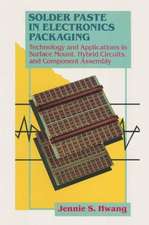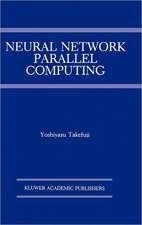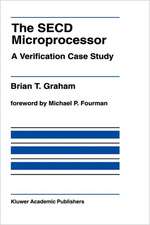Advances in Neuromorphic Hardware Exploiting Emerging Nanoscale Devices: Cognitive Systems Monographs, cartea 31
Editat de Manan Surien Limba Engleză Hardback – 31 ian 2017
| Toate formatele și edițiile | Preț | Express |
|---|---|---|
| Paperback (1) | 886.92 lei 6-8 săpt. | |
| Springer India – 13 iul 2018 | 886.92 lei 6-8 săpt. | |
| Hardback (1) | 892.90 lei 6-8 săpt. | |
| Springer India – 31 ian 2017 | 892.90 lei 6-8 săpt. |
Din seria Cognitive Systems Monographs
- 15%
 Preț: 647.59 lei
Preț: 647.59 lei - 20%
 Preț: 645.31 lei
Preț: 645.31 lei - 18%
 Preț: 957.62 lei
Preț: 957.62 lei - 15%
 Preț: 632.55 lei
Preț: 632.55 lei - 15%
 Preț: 643.99 lei
Preț: 643.99 lei - 20%
 Preț: 1447.17 lei
Preț: 1447.17 lei - 15%
 Preț: 629.73 lei
Preț: 629.73 lei - 15%
 Preț: 633.02 lei
Preț: 633.02 lei - 15%
 Preț: 639.90 lei
Preț: 639.90 lei - 20%
 Preț: 643.50 lei
Preț: 643.50 lei - 15%
 Preț: 640.55 lei
Preț: 640.55 lei - 15%
 Preț: 641.71 lei
Preț: 641.71 lei - 5%
 Preț: 1103.75 lei
Preț: 1103.75 lei - 15%
 Preț: 637.59 lei
Preț: 637.59 lei - 15%
 Preț: 648.24 lei
Preț: 648.24 lei - 20%
 Preț: 650.40 lei
Preț: 650.40 lei -
 Preț: 391.02 lei
Preț: 391.02 lei - 15%
 Preț: 643.48 lei
Preț: 643.48 lei - 20%
 Preț: 663.61 lei
Preț: 663.61 lei - 20%
 Preț: 652.54 lei
Preț: 652.54 lei - 20%
 Preț: 699.43 lei
Preț: 699.43 lei - 15%
 Preț: 640.88 lei
Preț: 640.88 lei - 20%
 Preț: 657.67 lei
Preț: 657.67 lei - 20%
 Preț: 1000.04 lei
Preț: 1000.04 lei - 20%
 Preț: 648.44 lei
Preț: 648.44 lei - 18%
 Preț: 886.92 lei
Preț: 886.92 lei - 20%
 Preț: 647.61 lei
Preț: 647.61 lei - 20%
 Preț: 651.09 lei
Preț: 651.09 lei - 20%
 Preț: 1161.71 lei
Preț: 1161.71 lei - 15%
 Preț: 642.68 lei
Preț: 642.68 lei - 20%
 Preț: 649.93 lei
Preț: 649.93 lei - 18%
 Preț: 944.19 lei
Preț: 944.19 lei
Preț: 892.90 lei
Preț vechi: 1088.90 lei
-18% Nou
Puncte Express: 1339
Preț estimativ în valută:
170.88€ • 176.53$ • 142.21£
170.88€ • 176.53$ • 142.21£
Carte tipărită la comandă
Livrare economică 25 martie-08 aprilie
Preluare comenzi: 021 569.72.76
Specificații
ISBN-13: 9788132237013
ISBN-10: 8132237013
Pagini: 210
Ilustrații: XIII, 210 p. 123 illus.
Dimensiuni: 155 x 235 x 14 mm
Greutate: 0.5 kg
Ediția:1st ed. 2017
Editura: Springer India
Colecția Springer
Seria Cognitive Systems Monographs
Locul publicării:New Delhi, India
ISBN-10: 8132237013
Pagini: 210
Ilustrații: XIII, 210 p. 123 illus.
Dimensiuni: 155 x 235 x 14 mm
Greutate: 0.5 kg
Ediția:1st ed. 2017
Editura: Springer India
Colecția Springer
Seria Cognitive Systems Monographs
Locul publicării:New Delhi, India
Cuprins
Phase Change Memory for Neuromorphics .- Filamentary resistive memory for Neuromorphics.- Metal oxide based memory for Neuromorphics.- Nano Organic Transistors for Neuromorphics.- Neuromorphic System design.- Neuromorphic System and algorithms optimization.- Memristor Technology for Neuromorphics.- PCMO based devices for Neuromorphics.- Resistive Memory for Neuromorphics.- Overall Perspective on Neuromorphic Hardware.
Notă biografică
Dr. Manan Suri (Member, IEEE) is an Assistant Professor with the Department of Electrical Engineering, Indian Institute of Technology – Delhi (IIT-Delhi). He was born in India in 1987. He received his PhD in Nanoelectronics and Nanotechnology from Institut Polytechnique de Grenoble (INPG), France in 2013. He obtained his M.Eng. (2010) and B.S (2009) in Electrical & Computer Engineering from Cornell University, USA. Prior to joining IIT-Delhi, he worked as a Senior Scientist with NXP Semiconductors, Belgium. His research interests include Non-Volatile Memory Technology, Unconventional Computing (Machine-Learning/Neuromorphic), and Semiconductor Devices. He holds several granted and filed US, European and Indian patents. He has authored book chapters and more than 30 papers in reputed international conferences and journals. He serves as committee member and reviewer for IEEE journals/conferences. He is a recipient of several prestigious national and international honors such as the IEI Young Engineers Award, Kusuma Outstanding Young Faculty Fellowship, and Laureat du Prix (NSF-France).
Textul de pe ultima copertă
This book covers all major aspects of cutting-edge research in the field of neuromorphic hardware engineering involving emerging nanoscale devices. Special emphasis is given to leading works in hybrid low-power CMOS-Nanodevice design. The book offers readers a bidirectional (top-down and bottom-up) perspective on designing efficient bio-inspired hardware. At the nanodevice level, it focuses on various flavors of emerging resistive memory (RRAM) technology. At the algorithm level, it addresses optimized implementations of supervised and stochastic learning paradigms such as: spike-time-dependent plasticity (STDP), long-term potentiation (LTP), long-term depression (LTD), extreme learning machines (ELM) and early adoptions of restricted Boltzmann machines (RBM) to name a few. The contributions discuss system-level power/energy/parasitic trade-offs, and complex real-world applications. The book is suited for both advanced researchers and students interested in the field.
Caracteristici
Employs a flexible format, so that it can be used either (a) as a regular graduate level course textbook or (b) as an advanced research manuscript in the field of neuromorphic hardware Places major emphasis on experimental results, fabricated device technology aspects and not just modeling/simulation-based results Offers highly relevant and interdisciplinary content, uniting the fields of nanoelectronics (devices/materials), computational neuroscience (learning rules/algorithms), and computing (architectures/applications) Includes supplementary material: sn.pub/extras





























